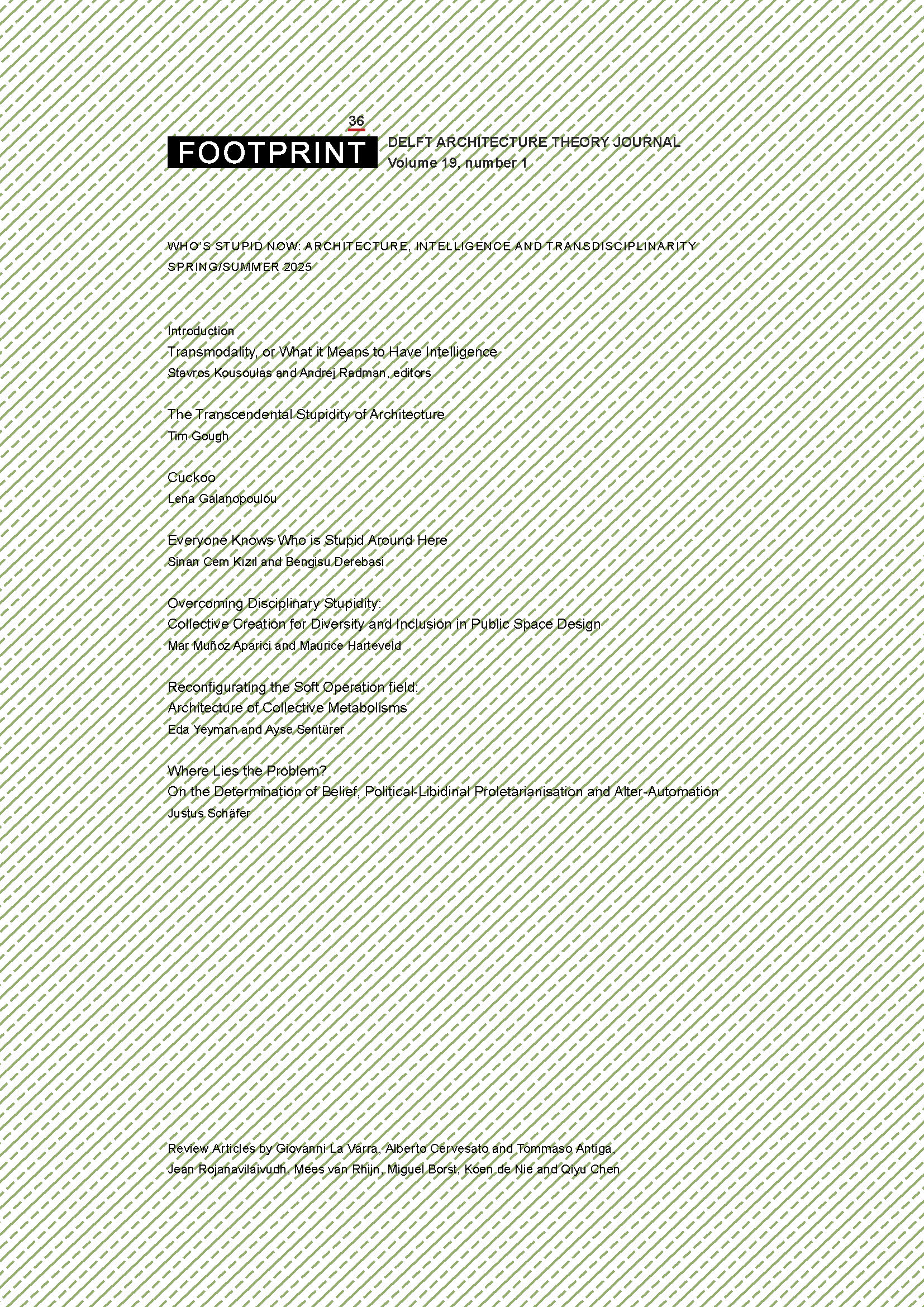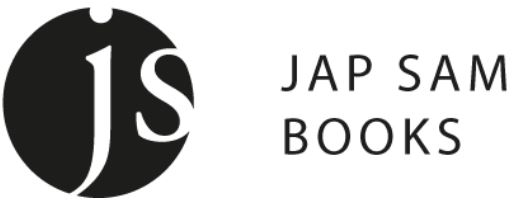Reconfiguring the Soft Operation Field
Architecture of Collective Metabolisms
DOI:
https://doi.org/10.59490/footprint.19.1.7497Abstract
The evolution of architecture calls for a redefinition of materialism, urging a departure from deterministic systems towards non-linear causality and systems far from equilibrium. This entails recognising the dissolution of human-inhuman boundaries and advocating for tactile and sensory bodies that initiate metabolic changes by penetrating environments. Isabelle Stengers critiques the tendency to frame thought within pre-existing planes, labelling it as stupidity, and advocates for an architecture that proliferates rather than condemns.
With this article, we propose to explore architecture’s singular conditions through the concept of trans-scalability, akin to transitioning from micro-subatomic to macro scales. We look at what enables transitions between scales, agents, fields and the realms of theory and practice. Additionally, we scrutinise how spatial construction practices, influenced by non-cartographic scale considerations and engaged with micro-subatomic dimensions, can impact contemporary architectural practices. To illustrate this, we present an alternative approach to transscalability through the work of Rachel Armstrong. With this new material reading, our aim is to view architecture as an interface between the world’s multiplicities and to explore how an architectural practice more attuned to the intersecting dynamics of various fluxes can be realised. With this approach, we aim to contribute to perceiving the world through its unstable and temporary material dimensions, thereby resisting stupidity.
References
Armstrong, Rachel, and Robert Hughes. The Art of Experiment: Post-pandemic Knowledge Practices for 21st Century Architecture and Design. London: Taylor & Francis, 2020.
Armstrong, Rachel, Rolf Hughes and Simone Ferracina. "Monstering: A Transdisciplinary Method for an Unstable World." Palgrave Communications 6, no. 1 (2020): 1–7.
Armstrong, Rachel. "How Protocells Can Make ‘Stuff’ Much More Interesting." Architectural Design 81, no. 2 (2011): 72.
Armstrong, Rachel. "Living Architecture." Interalia Magazine. Accessed March 2, 2024. https://www.interaliamag.org/interviews/rachel-armstrong-living-architecture/.
Armstrong, Rachel. Experimental Architecture: Designing the Unknown. New York: Routledge, 2019.
Armstrong, Rachel. Soft Living Architecture: An Alternative View of Bio-Informed Practice. London: Bloomsbury Publishing, 2020.
Armstrong, Rachel. Vibrant Architecture: Matter as a Codesigner of Living Structures. Berlin: De Gruyter Open, 2015.
Barad, Karen. Meeting the Universe Halfway: Quantum Physics and the Entanglement of Matter. Durham, NC: Duke University Press, 2007.
Beesley, Philip, and Rachel Armstrong. "Soil and Protoplasm: The Hylozoic Ground Project." Architectural Design 81, no. 2 (2011): 78–89.
Deleuze, Gilles, and Félix Guattari. A Thousand Plateaus. Translated by Brian Massumi. Minneapolis: University of Minnesota Press, 1987.
Fraser, Mariam, Celia Lury, and Sarah Kember, eds. Inventive Life: Approaches to the New Vitalism. London: Routledge, 2006.
Horton, Zachary. "The Cosmic Zoom: Scale, Knowledge, and Mediation." In The Cosmic Zoom, 12–13. Chicago: University of Chicago Press, 2021.
Jaque, Andrés. "The Dissident Architect: Reflections on Multimedia, Transscalar, and Transspecies Architecture." KoozArch. Accessed March 2, 2024. https://koozarch.com/interviews/the-dissident-architect-andres-jaque-reflections-on-multimedia-transscalar-and-transspecies-architecture.
Kodalak, Gökhan, and Stavros Kousoulas. "Simondoniana: Essays by Kodalak and Kousoulas, with Mutual Responses." Footprint: Delft Architecture Theory Journal 36, no. 1 (2022): 3–21.
Kugler, Peter N., and Robert E. Shaw. "Symmetry and Symmetry-Breaking in Thermodynamic and Epistemic Engines: A Coupling of First and Second Laws." In Synergetics of Cognition: Proceedings of the International Symposium at Schloß Elmau, Bavaria, June 4–8, 1989, edited by Hermann Haken, 296–331. Berlin: Springer Berlin Heidelberg, 1990.
Living Architecture. Accessed August 20, 2024. https://livingarchitecture-h2020.eu.
Moran, L. A. "Good Science Writers: Richard Lewontin." Sandwalk. July 3, 2008. http://sandwalk.blogspot.co.uk/2008/07/good-science-writersrichard-lewontin.html. Accessed April 19, 2014.
Negarestani, Reza. "Frontiers of Manipulation." In Speculations on Anonymous Materials, edited by Susanne Pfeffer, 201–214. Berlin: Sternberg Press, 2014.
"Objective." Living Architecture. Accessed August 20, 2024. https://livingarchitecture-h2020.eu/objective/.
"Partner Profiles." Living Architecture. Accessed August 20, 2024. https://livingarchitecture-h2020.eu/partner-profiles/.
Prigogine, Ilya, and Isabelle Stengers. Order Out of Chaos. New York: Bantam Books, 1984.
Radman, Andrej. "Generalised Chromaticism: The Ecologisation of Architecture." The Journal of Architecture 27, no. 4 (2022): 520.
Radman, Andrej. Ecologies of Architecture. London: Bloomsbury Publishing, 2022.
Rawes, Peg, ed. Relational Architectural Ecologies: Architecture, Nature and Subjectivity. London: Routledge, 2013.
Serres, Michel. Hermes: Literature, Science, Philosophy. Baltimore: The Johns Hopkins University Press, 1982.
Simondon, Gilbert. Individuation in Light of Notions of Form and Information. Translated by Taylor Adkins. Minneapolis: University of Minnesota Press, 2020 [1964].
Simondon, Gilbert. On the Mode of Existence of Technical Objects. Translated by Cecile Malaspina and John Rogove. Minneapolis, MN: Univocal, 2017.
Spiller, Neil, and Rachel Armstrong, eds. Protocell Architecture. Hoboken, NJ: John Wiley & Sons, 2011.
Spuybroek, Lars. "Matter and Image: The Pharmacology of Architecture." Architectural Intelligence 2, no. 1 (2023): 2.
Stengers, Isabel. Cosmopolitics. Vol. 1. Minneapolis: University of Minnesota Press, 2010.
Stengers, Isabelle, et al. In Catastrophic Times: Resisting the Coming Barbarism. London: Open Humanities Press, 2015.
Stengers, Isabelle. "Thinking Life: The Problem Has Changed." In Posthumous Life: Theorizing Beyond the Posthuman, edited by Claire Colebrook, 325–338. New York: Columbia University Press, 2017.
Downloads
Published
Issue
Section
License
Copyright (c) 2025 Eda Yeyman, Ayse Sentürer

This work is licensed under a Creative Commons Attribution 4.0 International License.
- Authors retain copyright and grant the journal right of first publication with the work simultaneously licensed under a Creative Commons Attribution License that allows others to share the work with an acknowledgement of the work's authorship and initial publication in this journal.
- Authors are able to enter into separate, additional contractual arrangements for the non-exclusive distribution of the journal's published version of the work (e.g., post it to an institutional repository or publish it in a book), with an acknowledgement of its initial publication in this journal.





